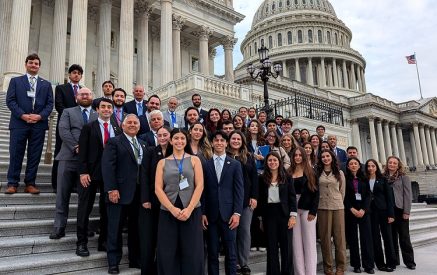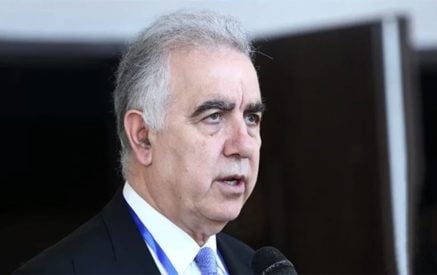The Armenian Weekly. On October 29, 2019, Armenian Americans scored a major victory in the halls of US Congress. For the first time in 35 years, the US House of Representatives adopted Resolution 296 affirming the facts of the Armenian Genocide.
I used the term affirming because contrary to many Armenian and non-Armenian commentators, this was not the first time that the United States has recognized the Armenian Genocide. In fact, this was the fifth American governmental recognition. As I have reported dozens of times in past years, the United States government first recognized the Armenian Genocide in 1951 when it sent an official document to the International Court of Justice (World Court) presenting the Armenian Genocide as an example of genocide. The US House of Representatives recognized the Armenian Genocide in two Resolutions adopted in 1975 and 1984, and Pres. Ronald Reagan issued a Presidential Proclamation on April 22, 1981 mentioning the Armenian Genocide.
Among the misrepresentations made by various commentators were statements like:
1. “The October 29, 2019 recognition of the Armenian Genocide by the House of Representatives was the first time in a century that the United States has recognized the Armenian Genocide.” It was not! In fact, the text of Resolution 296 itself lists all the previous US recognitions of the Armenian Genocide and describes it as affirmation, not recognition.
Read also
2. “Resolution 296 set a policy on the recognition of the Armenian Genocide by the US government.” It did no such thing. This Resolution, like the others before it, is a non-binding Resolution, expressing simply the will of Congress. It is not a law and it has no legal consequences.
3. “Resolution 296 obligates Pres. Trump to use the term genocide in his next April 24 statement.” It does not. The President can still use other euphemisms to describe the Armenian Genocide, if he wishes to, as he and other US Presidents have done since Pres. Reagan.
4. “Resolution 296 will allow Armenians to file lawsuits in US courts against Turkey demanding restitution for damages suffered during the Genocide.” This is not true. As mentioned above, two similar Congressional Resolutions were adopted in 1975 and 1984 and neither one helped Armenians win a single lawsuit against Turkey in US courts.
5. “After the passage of Resolution 296, if the US Senate adopts the counterpart Resolution (SRes.150), and if Pres. Trump signs it, then the Resolution becomes a law.” This is untrue, since both the House and Senate versions are “stand alone” Resolutions. Should the Senate version also be adopted, the Resolution will not go to Pres. Trump for his signature, since the House and Senate versions were not submitted as a “Joint Resolution.”
Nevertheless, none of the above clarifications are made to minimize the value of the adoption of Resolution 296 on October 29, 2019. Here are the reasons why this Resolution was a major victory for the Armenian Cause:
1. After trying to pass a genocide resolution in the House for 35 years, it is a major accomplishment for the Armenian American community to be able to finally score such a victory. It is not possible to continue demanding that the Armenian public support a cause for decades without a concrete result from time to time. This victory will energize Armenian-Americans to continue their commitment to the Armenian Cause and work harder to attain greater accomplishments.
2. While the passage of Resolution 296 does not obligate the President of the United States, it will increase the pressure on him to properly acknowledge the Armenian Genocide in his April 24 statement.
3. Resolution 296 also makes it more difficult for the Turkish government to continue its denials of the Armenian Genocide.
4. Paradoxically, the harsh reactions of the Turkish leaders to the adoption of Resolution 296 helped remind the Turkish people and others worldwide about the Armenian Genocide.
5. Thousands of articles, television reports and social media posts on the adoption of Resolution 296 helped further publicize the Armenian Genocide around the world. Over 100 years after the Genocide, the cry for justice remains alive thanks to the activism of Armenians and their supporters.
6. The passage of Resolution 296 is another step in Armenia’s struggle to pressure Turkey and the world community to take further steps to undo the damage caused by the Genocide, albeit delayed over a century!
7. Beyond setting straight the historical record, the effort over the passage of the genocide resolution is a political battle between the Armenian American community and the Turkish government and its paid lobbyists as to which side has more political clout in Washington. The overwhelming victory (405 to 11 votes) is a clear indication of the smashing defeat of Turkey and the total victory of Armenians.
8. The Turkish government has wasted tens of millions of dollars over the years hiring high-powered American lobbying firms in a failed attempt to block the approval of Armenian Genocide Resolutions by the US Congress. It is impossible to misrepresent genocide as a humane act no matter how many billions of dollars Turkey spends on lobbyists!
9. Turkey’s defeat also sends a message to the Turkish public that the taxes they have paid are being squandered by their government to deny the undeniable.
10. Some have made the excuse that Congress took advantage of the souring relations between Turkey and the United States to pass Resolution 296. While this is true, there are several counter-arguments:
– Congress is a political body; hence all its deliberations and decisions are of a political nature;
– If it weren’t for the diligent efforts of Armenian-American organizations and the Armenian community, there was no guarantee that this Resolution would have appeared on the agenda of the House of Representatives. Since the US Congress was unhappy with Turkey’s invasion of Northern Syria, the House of Representatives would have been satisfied by passing a Resolution on October 29, 2019, placing sanctions on Turkey for its barbaric attacks against Kurds. However, because of Armenian activism, the House also adopted on the same day the Resolution on the Armenian Genocide.
– We cannot be so naive as to expect that any government would defend the Armenian Cause if doing so would have been contrary to its own interests. It is perfectly reasonable that the condemnation of the Armenian Genocide happened to coincide with Congress’ anger at Turkey for other reasons. In fact, the more Armenians can find reasons to match their interests with those of other countries, the more successful they will be in their pursuit of the Armenian Cause.
For the next step, I hope the US Senate will shortly pass Senate Resolution 150. This is important, since the US Senate has never adopted a Resolution acknowledging the Armenian Genocide. And maybe next year, the Armenian Genocide Resolution could be reintroduced, but this time as a “Joint Resolution,” which would mean that should the Resolution pass both Houses of Congress and the President signs it, the Armenian Genocide would become US law, not just a “non-binding” Resolution. This would obligate all future American Presidents to use the term Armenian Genocide in their April 24 statements or on any other occasion.
By Harut Sassounian Publisher,
The California Courier
Photo: (ANCA/Twitter, October 30, 2019). Above the Fold | Wall Street Journal quotes ANCA’s Aram Suren Hamparian: “… the Armenian Genocide resolution establishes the rejection of genocide denial as a matter of U.S. policy.”



























































